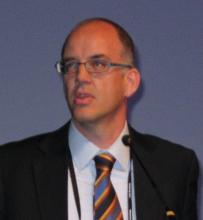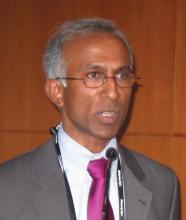AMSTERDAM – Wide adoption of stereotactic ablative radiation as radiotherapy for elderly patients with stage 1 non–small cell lung cancer in the Netherlands produced a dramatic rise in overall survival during the 2000s.
Dutch national data showed that median overall survival in patients aged 75 year or older with stage I NSCLC that was treated with radiation therapy jumped from 17 months in 2001-2003 to 26 months in 2007-2009 (P = .001), an improvement largely attributable to substantially increased use of sterotactic ablative radiation therapy (SABR), Dr. Cornelis J.A. Haasbeek said at the World Conference on Lung Cancer, which was sponsored by the International Association for the Study of Lung Cancer.
Dutch radiation oncologists began using SABR in 2003, and by 2009 more than 75% of early-stage NSCLC patients who received radiation therapy had it in the form of SABR.
"Our study provides high-level evidence to support the efficacy of modern SABR," said Dr. Haasbeek, a radiation oncologist at Vrije Universiteit Medische Centrum, Amsterdam.
SABR cut the number of treatments needed, compared with conventional radiation therapy, by 5- to 10-fold while also boosting efficacy, and it offers a better option for patients who are too old and frail to undergo surgical resection of their cancer. SABR is also a reasonable option for selected operable patients, said Dr. Suresh Senan, professor and vice-chairman of radiation oncology at Vrije Universiteit Amsterdam and senior investigator of the new report.
"The emerging data say that SABR is an option in patients who do not want to accept the risks of surgery, or for patients told by their surgeons that they have a significantly increased surgical risk. SABR is curative treatment for a frail group, producing excellent local control with very low toxicity," Dr. Senan said in an interview. "Elderly patients who could undergo open surgery should also be informed about SABR as an alternative curative, outpatient modality."
The main drawback of SABR compared with surgery is less-extensive long-term experience. "We have no track record of more than 5 years in a substantial number of patients, so there may still be surprises on recurrences," he said.
"What is important is that patients make a [treatment] decision, and are not told that they are too old for treatment. Surgery has the advantages of allowing for accurate tissue diagnosis and intraoperative staging, and in patients with emphysema, removal of the affected lung can improve lung function," commented Dr. David A. Waller, a thoracic surgeon at Glenfield Hospital in Leicester, England. "The risk [from surgery] is the general anesthesia, especially in patients with existing cardiovascular morbidity. It’s the patients with comorbidities who might do best with radiation therapy."
Speaking as a discussant of the Dutch report, Dr. Hak Choy said that the new findings and prior results make SABR a clear choice for elderly, inoperable patients, but existing data did not yet adequately support substituting SABR for surgery in operable patients. The definitive role for SABR in operable patients will grow clearer with results from two randomized studies now underway that compare SABR and surgery in high-risk operable patients, said Dr. Choy, a professor of radiation oncology at the University of Texas Southwestern Medical Center in Dallas.
To assess the impact that SABR had on stage I NSCLC in elderly patients in the Netherlands during the 2000s, Dr. Senan, Dr. Haasbeek, and their associates analyzed data from the Netherlands Cancer Registry. The registry had 4,605 patients aged 75 or older with stage I NSCLC during 2001-2009. This included 1,678 patients who were treated with surgery (37%), 1, 570 treated with radiotherapy (34%), and 1,337 treated by neither method (29%). During the 9 years reviewed, the percentage of patients undergoing radiotherapy increased from 31% of patients in 2001-2003 to 38% in 2007-2009. This paralleled a drop in untreated patients from 32% to 25%. Surgery use stayed flat over the period.
Median overall survival for all patients rose from 16 months in 2001-2003 to 24 months in 2007-2009 (P = .001), a change linked to survival increases in both radiation-treated patients and those who got surgery. Patients with surgical resections had a median overall survival of 36 months in 2001-2003, and median survival not yet occurred in patients with surgery in 2007-2009.
The better median survival in the surgery patients in part depends on the superior physical status of patients eligible for surgery. Other factors that may have boosted postsurgical survival include improved perioperative care, reduced numbers of higher-risk patients treated with surgery as radiation use increased, improved surgical techniques such as video assistance, and a trend toward more surgery being done in specialized centers, Dr. Haasbeek said.


